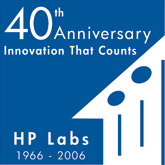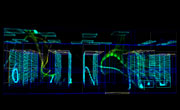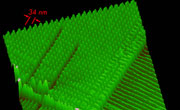|
Throughout
its history, HP Labs has created or contributed significantly
to technological innovations that have had a major impact
on the industry. Many of these were “firsts” and unique in
their time. (Some are now a part of Agilent Technologies, the measurement-solutions company that was spun off from HP in 1999.)
Today, HP Labs continues its tradition of innovation with projects as diverse as fully automated data centers, digital commercial printing with offset quality, media platforms that can store entire libraries of diverse data and award-winning quantum computing research.
Here are just 40 historic innovations from HP Labs that
either have – or will – make a difference:
1966
HP's first computer, the HP2116A, is introduced.
Rugged and reliable, it is the first go-anywhere,
do-anything computer.
1966
HP Labs develops the first commercially available
light-emitting diode (LED). Applications include alphanumeric
displays such as indicator lights and traffic signals.
1967
HP's cesium-beam atomic clocks set the world's time standards, coordinating international time to within a millionth of a second. The clocks, which grow more accurate over the decades, are used in a host of time-critical applications that include avoiding airplane collisions, running telecommunications systems and even operating space shuttles.
1968
First programmable scientific desktop calculator: The HP 9100A – virtually the first PC – stores programs on a magnetic card and can solve science and engineering problems 10 times faster than most other machines. It paves the way for the company's workstation business.
1971
A key role HP Labs plays within the company is to
provide answers to tough technical problems. In response
to a request from division engineers working on the 2100A
computer, HP Labs provides a last-minute bantam power supply
-- 500 watts in 800 cubic inches -- keeping the product on
track for introduction
1971
Work with lasers produces a laser interferometer capable of measuring to millionths of an inch. The device is still the tool of choice in microchip manufacturing. Similar technology also produces a laser instrument that becomes the first electronic surveying tool.
1972
First pocket scientific calculator: Engineers
rise to Bill Hewlett's challenge to create a scientific calculator
that fits in a shirt pocket. The HP-35 makes the slide rule
obsolete.
1975
HP simplifies instrument systems by creating a standard interface. The electronics
industry adopts the HP-IB (interface bus) as an international standard to
allow one or more instruments to connect easily to a computer.
1979
Researchers create fused silica capillary columns for gas chromatography, which revolutionizes chemical analysis.
1980
First 64-channel ultrasound product for imaging human heart in real time is produced based on technology from HP Labs.
1980
Using licensed copier technology from Canon, researchers add an optical package and other engineering innovations to help HP create the first commercial laser printer for general office use. The printer is so quiet in can be used in a library
1981
“Grit wheel” plotter technology: Scientists revolutionize how paper and pen are
moved in plotters using a novel “grit wheel” technology. It launches a new line
of large, drafting-quality plotters at half the cost of the then-current technology.
1984
HP launches its first inkjet printer, which is based on thermal inkjet technology developed in Labs in the 1970s. Just as the HP-35 calculator replaced the manual slide rule forever, the ThinkJet -- which is both high-quality and low-cost -- spells the end for the noisy dot-matrix printer.
1986
RISC architecture: HP Labs helps the company be the first to commercialize
RISC (Reduced Instruction Set Computing). RISC executes instructions
faster and does more work than previous generations of chips
1986
3D graphics come of age with the HP SRX, the first generation
of graphics workstations. BAsed on architecture created in the lab, the device helps HP become a leading graphics workstation
vendor.
1989
HP introduces its first Digital Data Storage (DDS) drives, based on pioneering
technology from Labs for using helical scan tape recording for
data storage. DDS becomes one of the world's the best-selling tape backup formats.
1991
Color desktop printing: Scientists create fundamental color
(sRGB), compression and half-toning algorithms for the
DeskJet 500C, dramatically reducing the cost of color
printing.
1994
64-Bit architecture (Itanium): Building on work that began in in the lab in 1981,
researchers team with Intel engineers to develop what eventually becomes
Intel's next-generation Itanium architecture, launched in 2001. It advances
computing from 32 to 64 bits.
1995
Telecommunications revolution: Teams from HP businesses and the lab develop standard telecommunications computing platforms to replace the inflexible proprietary equipment of the time. Today, these technologies are found in the Open Call family of products, which provide services to more than 100 million people in 100 countries.
1997
Researchers produce technology that enables a gene array product for DNA analysis.
1997
Digital photography: HP Labs helps the company get into the digital photography
business, providing a pipeline of imaging innovationslike adaptive
lighting, color balance, automatic red-eye removal that add up to a “custom
photo lab” inside HP cameras.
1998
Navigation technology devised for a handheld copier is later
licensed for use in cordless mice. The paper-motion sensing technology can also be seen in today's printers.
1999
Molecular logic gate: Scientists from HP and UCLA build the world's first
molecular logic gate, a fundamental step in the creation of chemically assembled
electronic nanocomputers. Researchers hope to pave the way for processors that are far more powerful than today's chips, but just a fraction of the size and cost.
1999
Ubiquitous computing: Hey! Everything Has A Website (HEHAW), a
concept patented by HP Labs researchers, becomes the basis for the experimental CoolTown research
project to show how people, places and things can be connected on the Web.
2001
Utility computing: Researchers help create the Utility Data Center, believed to be the first true
implementation of a utility computing technology for enterprises looking
to make better use of their resources. It builds on previous work at HP Labs,
including Web QoS, which helps service providers meet customers' fluctuating
demands.
2002
Researchers create the technology for the first rewritable DVD system (DVD+RW) compatible with standard DVD players.
2002
HP Labs leads the company into the digital publishing
business, by establishing a technical relationship with Indigo
N.V., which HP acquires. Indigo presses offer technology called liquid electrophotography (LEP), which combines digital laser imaging, ultra-small ink particles and a liquid transport system to produce prints comparable to offset quality.
2002
A team of chemists, physicists, engineers and computer scientists working in quantum computing produce the highest density electronically addressable memory to date. The laboratory demonstration circuit, a 64-bit memory using molecular switches as active devices, fits inside a square micron -- an area so tiny that more than 1,000 could fit on the end of a human hair.
2003
Researchers help the U.S. government fight counterfeiters by using their deep technical knowledge in image processing, color management and information embedding to come up with a range of deterrence methods that could be used in printing currency.
2003
The Grid: HP announces grid-enabled services, solutions and products to help
enterprises better manage and capitalize on change. These offerings are based
on numerous technologies developed in HP Labs.
2003
Smart Cooling: Scientists' work using computational fluid dynamics to model heat distribution in a data center leads to HP's smart cooling solution,
which potentially can dramatically reduce energy use and save millions
of dollars annually.
2004
Model-based technology from HP Labs is a key component in the creation of HP
OpenView Automation Manager, which helps automatically shift IT resources
to meet shifting business priorities.
2004
HP releases a new version of Jena, its open source Semantic Web toolkit. With Jena, more of the Web's content can be created in a machine-readable form, which allows computers to find and integrate information from diverse sources.
2004
An HP Labs image-compression algorithm is used to create some of the spectacular, high-resolution images of Mars transmitted by NASA's Spirit Rover spacecraft. The images help scientists on earth closely study the surface of Mars from 106 million miles away.
2004
Leveraging technology developed by HP Labs, HP's Digital Media Platform enables media companies to create content once and to reuse it many times in any standard or format.
2005
Virus Throttle, a technology developed in HP Labs, is designed to
quickly control the spread of viruses across corporate networks and reduce
the damage they cause during an attack. The software is currently available in select HP products.
2005
An animated short called "The Painter "becomes the first film produced using Labs' experimental utility-services solutions. Researchers then apply these technologies and more to something bigger -- teaming with DreamWorks to help produce the animated fairy tale, "Shrek 2." This eventually leads to HP's Flexible Computing Services, which target the oil and gas, financial services and healthcare industries.
2005
Crossbar latch: Researchers demonstrate that the crossbar latch they invented
could replace the transistor – the fundamental building block of computers
for the last half century -- and lead to a new way to construct computers
in the future.
2006
Streaming media: Researchers work closely with HP's Open Call Business unit to add streaming media and network overlay technologies to enable high-quality, reliable transfer of multimedia over 3G phone networks.
2006
Color scientists are making fundamental contributions to the International Color Consortium (ICC), which helps ensure that colors captured on one device can be reproduced satisfactorily on others. By making color management more predictable, researchers hope to help transform commercial printing into a Web-based business.
|



